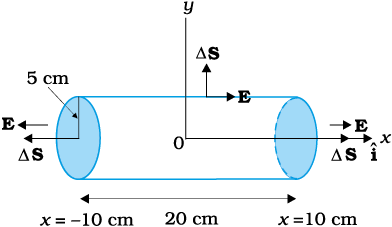A cylinder of radius r and length l is placed in an uniform electric field parallel to the axis of the cylinder. The total flux for the surface of the cylinder is given by-
1. zero
2.
3. E
4. 2E
1. zero
2.
3. E
4. 2E
Polar molecules are the molecules:
| 1. | that acquires a dipole moment only when the magnetic field is absent. |
| 2. | has a permanent electric dipole moment. |
| 3. | has zero dipole moment. |
| 4. | that acquire a dipole moment only in the presence of an electric field due to displacement of charges. |
A dipole is placed in an electric field as shown. In which direction will it move?

| 1. | towards the left as its potential energy will decrease. |
| 2. | towards the right as its potential energy will increase. |
| 3. | towards the left as its potential energy will increase. |
| 4. | towards the right as its potential energy will decrease. |
Which statement is true for Gauss law-
1. All the charges whether inside or outside the gaussian surface contribute to the electric flux.
2. Electric flux depends upon the geometry of the gaussian surface.
3. Gauss theorem can be applied to non-uniform electric field.
4. The electric field over the gaussian surface remains continuous and uniform at every point.
Two point charges placed in a medium of dielectric constant 5 are at a distance r between them, experience an electrostatic force ‘F’. The electrostatic force between them in vacuum at the same distance r will be-
1. 5F
2. F
3. F/2
4. F/5
Two point charges +8q and -2q are located at x=0 and x=L respectively. The point on x axis at which net electric field is zero due to these charges is-
1. 8L
2. 4L
3. 2 L
4. L
The accelerations of electron and proton due to the electrical force of their mutual attraction when they are 1 Å (=) apart are respectively: (\(m_p=1.67\times10^{-27}~\text{kg},~m_e=9.11\times10^{-31}~\text{kg}\))
| 1. | \(2.5\times10^{22}\) m/s2, \(2.5\times10^{22}\) m/s2 |
| 2. | \(2.5\times10^{22}\) m/s2, \(1.4\times10^{19}\) m/s2 |
| 3. | \(1.4\times10^{19}\) m/s2, \(2.5\times10^{22}\) m/s2 |
| 4. | \(1.4\times10^{19}\) m/s2, \(1.4\times10^{19}\) m/s2 |
1. \(\dfrac{Z e}{4 \pi \varepsilon_{0}} \left(\dfrac{1}{r^{2}} - \dfrac{r}{R^{3}}\right)\)
2. \( \dfrac{Z e}{4 \pi \varepsilon_{0}} \dfrac{1}{R^{2}}\)
3. \( \dfrac{Z e}{4 \pi \varepsilon_{0}} \dfrac{1}{r^{2}}\)
4. \( \dfrac{Z e}{4 \pi \varepsilon_{0}} \dfrac{r}{R^{3}}\)
An electric field is uniform, and in the positive x-direction for positive x, and uniform with the same magnitude but in the negative x-direction for negative x. It is given that E = N/C for x > 0 and E = – N/C for x < 0. A right circular cylinder of length 20 cm and radius 5 cm has its centre at the origin and its axis along the x-axis so that one face is at x = +10 cm and the other is along the x-axis so that one face is at x = +10 cm and the other is at x = –10 cm (as shown in the figure). What is the net charge inside the cylinder?

An electric field is uniform, and in the positive \(x\)-direction for positive \(x\), and uniform with the same magnitude but in the negative \(x\)-direction for negative \(x\). It is given that \(\vec{E}=200\hat{i}\) N/C for \(x>0\) and \(\vec{E}=-200\hat{i}\) N/C for \(x<0\). A right circular cylinder of length \(20~\text{cm}\) and radius \(5~\text{cm}\) has its centre at the origin and its axis along the \(x\text{-}\)axis so that one face is at \(x= + 10~\text{cm}\) and the other is at \(x= -10~\text{cm}\) (as shown in the figure). What is the net outward flux through the cylinder?
1. \(0\)
2. \(1.57~\text{Nm}^2\text{C}^{-1}\)
3. \(3.14~\text{Nm}^2\text{C}^{-1}\)
4. \(2.47~\text{Nm}^2\text{C}^{-1}\)



